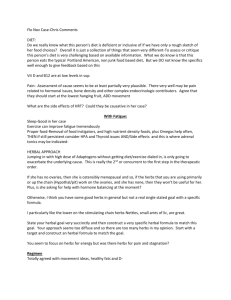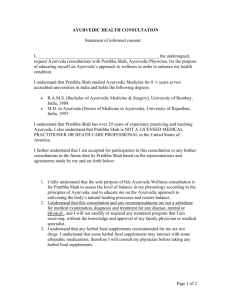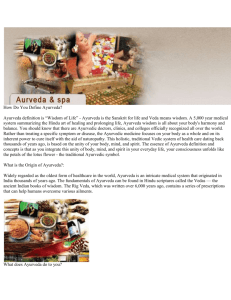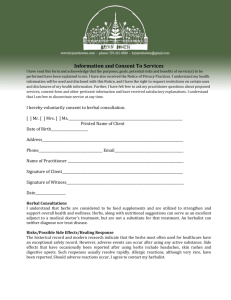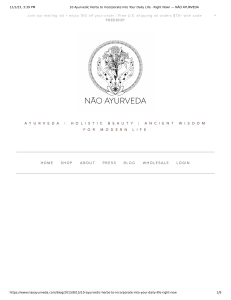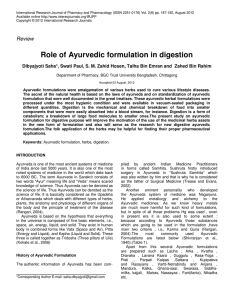Ayurvedic medicine
advertisement
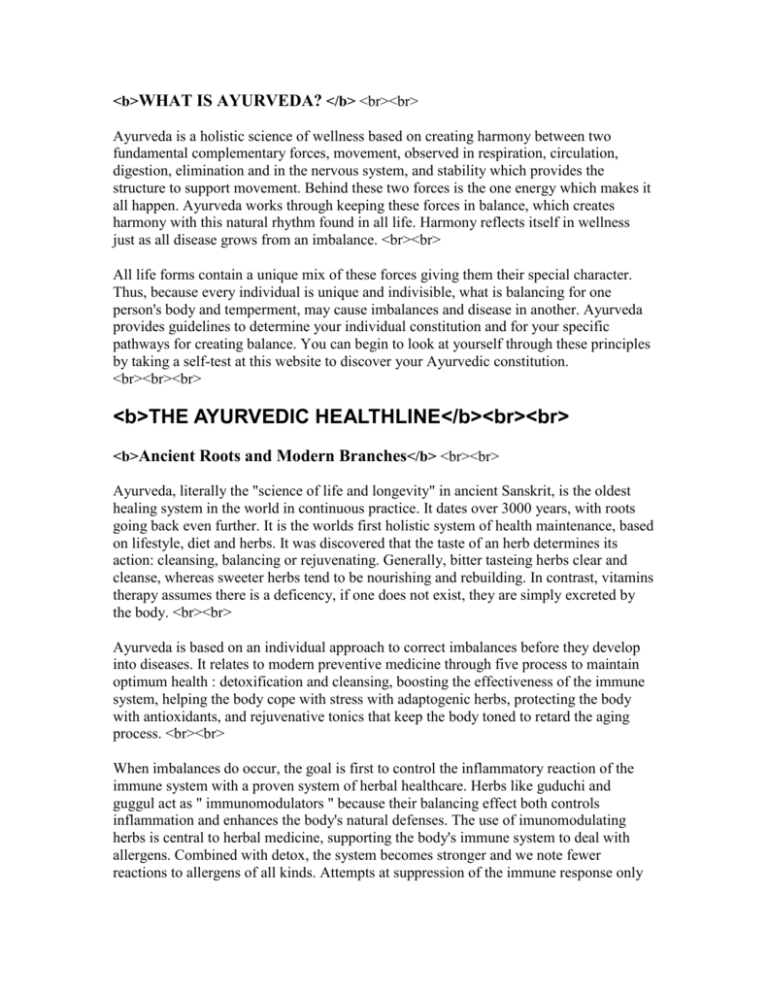
<b>WHAT IS AYURVEDA? </b> <br><br> Ayurveda is a holistic science of wellness based on creating harmony between two fundamental complementary forces, movement, observed in respiration, circulation, digestion, elimination and in the nervous system, and stability which provides the structure to support movement. Behind these two forces is the one energy which makes it all happen. Ayurveda works through keeping these forces in balance, which creates harmony with this natural rhythm found in all life. Harmony reflects itself in wellness just as all disease grows from an imbalance. <br><br> All life forms contain a unique mix of these forces giving them their special character. Thus, because every individual is unique and indivisible, what is balancing for one person's body and temperment, may cause imbalances and disease in another. Ayurveda provides guidelines to determine your individual constitution and for your specific pathways for creating balance. You can begin to look at yourself through these principles by taking a self-test at this website to discover your Ayurvedic constitution. <br><br><br> <b>THE AYURVEDIC HEALTHLINE</b><br><br> <b>Ancient Roots and Modern Branches</b> <br><br> Ayurveda, literally the "science of life and longevity" in ancient Sanskrit, is the oldest healing system in the world in continuous practice. It dates over 3000 years, with roots going back even further. It is the worlds first holistic system of health maintenance, based on lifestyle, diet and herbs. It was discovered that the taste of an herb determines its action: cleansing, balancing or rejuvenating. Generally, bitter tasteing herbs clear and cleanse, whereas sweeter herbs tend to be nourishing and rebuilding. In contrast, vitamins therapy assumes there is a deficency, if one does not exist, they are simply excreted by the body. <br><br> Ayurveda is based on an individual approach to correct imbalances before they develop into diseases. It relates to modern preventive medicine through five process to maintain optimum health : detoxification and cleansing, boosting the effectiveness of the immune system, helping the body cope with stress with adaptogenic herbs, protecting the body with antioxidants, and rejuvenative tonics that keep the body toned to retard the aging process. <br><br> When imbalances do occur, the goal is first to control the inflammatory reaction of the immune system with a proven system of herbal healthcare. Herbs like guduchi and guggul act as " immunomodulators " because their balancing effect both controls inflammation and enhances the body's natural defenses. The use of imunomodulating herbs is central to herbal medicine, supporting the body's immune system to deal with allergens. Combined with detox, the system becomes stronger and we note fewer reactions to allergens of all kinds. Attempts at suppression of the immune response only leads to greater and greater recurring symptoms. The next step is to follow guidelines based on Ayurvedic principles for a return to balance and rejuvenation. <br><br> The concept of a gentle and continuous detoxification in formulas like triphala, stems from the fact that many ailments and diseases are causes by impurities not being properly eliminated. Overeating in excess of one's ability to digest and assimilate nutrients is a major cause of creating toxins in the body. Improper digestion leads to overloading the liver and eliminative processes. The body reacts to undigested food like any other toxin. Ayurvedic cooking is light but nourishing, using herbs that enhance digestion and proper assimilation. Supporting the liver and improving digestion also results in a purer blood quality that is reflected in healthier skin and hair. For other herbs to enter the system, first it must be cleaned. <br><br> We are constantly subjected to free radicals in our environment, and the oxidative cell damage by free radicals is a major cause of degenerative diseases. Antioxidants scavenge these free radicals and limit the damage. The Ayurvedic phamacology* contains some of the most powerful antioxidant herbs available to prevent degenerative diseases. For example, Amalaki, or Indian Gooseberry is prized for its concentrations of naturally occurring vitamin C . This herb has been taken for centuries as an herbal jam called Chyavanprash, fortified with other balancing herbs as an antioxidant to prevent the occurrence of free radical chain reactions. <br><br> Adaptogenic herbs have the ability to work as a biological response modifier to environmental and psychological stress. Adaptogens in herbs like ashwagandha support adrenal function by supporting the endocrine system. Through glandular support, they have a broad spectrum effect, energizing all major systems as well as regulating their function as well. <br><br> Ayurvedic texts contained complete sections on anti-aging. The "rasayanas" were the rejuvenative tonics that kept cells young and helped reverse age related damage. The objective is that all functions of the body are kept toned and working at optimum effectiveness. The use of herbal tonics as a part of a daily health regimen is found everywhere in traditional medicine. It is a concept that not only incorporates all the concepts of detox, antioxidant, immunomodulation and adaptogenic as well, but focuses on development of a specific lifestyle plan including individual dietary and exercise guidelines as well. Since we are all unique in our own way, best results occur when we follow a regimen designed specifically for us. Hence an Ayurvedic practitioner's role today is to complement acute care medicine with a viable system of health maintenance. <br><br><br> <b>AYURVEDIC PERSPECTIVES ON MODERN DISEASES</b><br><br> <b>Ayurvedic Guidelines for Cancer Prevention</b> <br><br> Our body cells are surrounded by fluids which should be slightly alkaline in order to sustain life. If these fluids, especially the blood, becomes more acidic, our physical condition will first manifest fatigue and tendencies to catch colds and flu. As these fluids become more acidic, our condition increases to headaches and chronic fatigue. Our body will begin to deposit these excess acid forming substances in some area of the body such as breasts in women or the prostate in men. Cells which adapt to an acid environment are called malignant. <br><br> Ayurveda recommends an on-balance alkaline forming diet to maintain healthy cells. High acid forming foods such as eggs, red meats, cheese and sugar should be replaced with moderate to low acid forming foods such as whole grains and legumes. The majority of foods should be alkaline forming such as those found in seasonal fruits and vegetables and natural condiments such as soy. You can receive a free copy of acid & alkaline forming foods by email. Important lifestyle routines which help alkalanize are breathing excercises and warm-cold showers. Polarity Therapy and other stress reducing routines are essential to healing (see article below on Stress Management). <br><br> Herbs should be taken which help clean the blood of excess acidity and restore health. Traditionally, bitter herbs such as amalaki, manjista or guggul have been incorporated into balanced formulas such as triphala which can be taken over longer periods of time for health maintenance (please refer to herb history page). The great law of cause and effect is always operating and cannot be circumvented by only relieving symtoms. However, the law cuts both ways - by understanding how the disease was created, we can find the path back to health. Lastly, it is important to remember that every situation has a front as well as a back if we just will look for it. <br><br> <b>Gugglus for Maintaining Healthy Joints and Heart</b><br><br> One of the oldest and most famous herbs in Ayurvedic Medicine, Gugglu ( commiphora mukul ) is a gum resin and a relative of the Biblical botanical myrrh. There is a is a whole class of formulas containing gugglu combined with other herbs. Gugglu is considered an antiseptic and a carrier of herbs with specific properties which are needed for restoring balance for healthy joints. It was discovered that Gugglu being a resin, contained a sticky quality which attracts it to the synovial fluid in the joints. For example, if there was dryness or a lack of synovial fluid , gugglus resinous qualities acted as a lubricant (Yogaraj Gugglu)and foods to balance vata were given. <br><br> Toxins ( called ama ) which are formed mainly from undigested protein are also sticky and attracted to synovial fluid. From time to time , the immune system flushes these toxins out and this process creates an inflammatory condition. Arthritis is the name modern medicine give to this process when it becomes chronic. Herbs which have a cooling and cleansing quality (Kaishore Gugglu) were given in these situations, with foods to balance a pitta aggravation. If there was more of a kapha condition present with excess fluids and swelling, the appropriate drying foods were given and diuretics were combined (Punarnavadi or Goksuradi Gugglu) to clear fluids and help to restore balance to the tissues. Boswellia (salai guggal) is a tree gum resin with similar properties combined with other herbs to treat inflammatory conditions (Artrex formula). <br><br> More recently the cleansing properties of Gugglu have been discovered in the treatment of elevated blood cholesterol. Ancient texts reveal Ayurvedic physicians diagnosed the condition we call arteriosclerosis ( hardening of the arteries ) before 600 B.C. They described it as characterized by over eating and a lack of exercise which impaired metabolism and obstructed channels with fatal results. To treat it they used gugglus. Not surprisingly many Ayurvedic heart formulas contain gugglu combined with arjuna, which supports heart function and ashwagandha an adaptogen which increases tolerance to stress in our modern lifestyles. <br><br> <b>Maintaining Healthy Blood Glucose Levels</b> <br><br> Digestion and Assimilation of nutrients. <br><br> Ayurveda looks at proper digestion and assimilation of nutrients as a the root of health or disease. In blood sugar problems it is important to create an orderly breakdown of carbohydrates in the system. There are three types of carbohydrates. The simplest form are the monosaccharides, of which the most important for us is glucose. Next are the disaccharides, the most important being sucrose, lactose and maltose. Polysaccharides are the last type, which are very complex, being composed of enormous molecules made of many monosaccharide units - about 10 for glycogen, 25 for starch and 110 to 200 for cellulose. <br><br> Having small molecules, monosaccharides reach the intestinal wall and are directly absorbed into the body. Disaccharides must be broken down to monosaccharides by various enzymes, then absorbed by the intestinal wall. The absorption of these carbohydrates is very fast and within a short time glucose enters the bloodstream, upsetting the level of glucose in the blood. The liver and pancreas are called in to restore balance. As these situations continue, the adrenals begin to respond, resulting in organ fatigue. However, in the case of polysaccharides, the larger molecules have to pass through many levels of digestion, slowing the rate of absorption into the bloodstream. Therefore, a diet including more whole grains is helpful in maintaing healthy blood sugar levels. <br><br> <b>Balancing Herbs</b> <br><br> Gymnema sylvestre (shardunika)has been used in Ayurvedic formulas for centuries to assist in maintaining healthy blood glucose levels, stimulate the production of insulin and reduce the craving for sweets.It can be purchased as a single herb in tablet or capsule form or purchased in proprietary formulations such as Sweet Ease or Glucosim. <br><br> <b>Constitutional Perspective</b> <br><br> Blood sugar problems can be found in both pitta and kapha disorders. The incomplete buring of from direct ingestion of simple carbohydrates contributes to high acid levels in the body aggravating pitta. On the other hand, high kapha levels tend to suppress the production of insulin. If you are having blood sugar problems, You may find it helpful to take the self-test and use Ayurveda to establish a direction for you to move back to balance and health. <br><br> <b>Stress Management </b><br><br> Prana is the vital life force that supports mind and body. It is like the electricity that drives an electric appliance. The appliance, like our mind and body is inoperable without it. It is also known as chi in China (as in Tai Chi) and Ki in Japan (as in Reiki). Prana takes five forms: prana supports respiration, apana is the downward energy which supports elimination, samana distributes nourishment, vyana supports motor function and udana is the upward force that supports functions like our ability to speak. This intelligent force is also known as Kundalini, when seen in her role in our spiritual unfolding. <br><br> According to Ayurveda, disease and delusion develop when this vital life force is blocked by continued holding tension in the body as a reaction to stressful situations. Stress is a mind-body reaction which occurs when we do not have the energy needed to deal with the situation at hand. Long term situations often are job or relationship related or just from living from modern social values related to over achievement without taking time off to rejuvenate body and mind. We can certainly question our beliefs if we find that they are not supporting us! <br><br> Human beings or human doings? Being must presuppose doing, so we can never accomplish anything without first just being. So honoring just being can't be less important than doing or achieving? Spirit is whole in itself, like a circle or a cell. A cell divides itself into another like itself in the process of mitosis and another whole is created with both energies in balance. So it is only gross ignorance that judges being as less important than doing. Relaxation honors being, the key to maintaining balance with doing. Nature shows that we balance activity with rest in order to stay vital. We can see that this rhythm is also the key to sustaining our efforts to create what matters most for us. <br><br> Providing understanding and guidelines for balance in body, mind and spirit, Ayurveda gives us Polarity Therapy as well as herbal healthcare to maintain the flow of this vital energy throughout our mind and body. Ashwagandha can be taken daily for its adapogenic or anti-stress effects. Formulas such as Geriforte by HPS or Stress Ease by Banyan build energy reserves and increase our tolerance to potentially stressful situations. <br><br> Polarity Therapy has been used for centuries to clear our wireless energy system of painful blocks. Once energy circuits are reconnected, we feel rejuvenated and relaxed as our vital systems have the energy they need to function. The mind is like an empty vase of consciousness. We can choose our feelings by the contents that we put in it. When we put in a relaxing sensation created by Polarity Therapy, we feel energized and a sense of well being. With each breath, we let the pleasure flow in and the stress flow out. <b>Biorhythm Charts- a useful tool for Energy Management </b><br><br> Biorhythm charts reveal the highs and lows periods of our vitality - physically, emotionally and intellectually. They also forecast critical dates upon which the individual, in a state of lease resistance, will be more vulnerable to risks than normally. These dates do not correspond only to the lowest points on the curves, as would seem logical, but also at the points at which the curves intersect the axis, i.e. the phase changes. In other words, in a critical day in which you find one or more low energy levels, it would be more significant to consider your activity or decision making level than one in which a critical day was balanced with other higher energy levels. <br><br> Awareness of your personal biorhythms can help you plan most opportune times for making major decisons and other activities which may require higher physical, intellectual or emotional energy levels. The challenging days are also a good time rely on Ayurvedic formulas such as StressCare, Mental Clarity or Tranquil Mind for support. You can receive your personal Biorhythms Chart for the current month for free by emailing us your date and time of birth when you place an herbal or product order. <br><br> <b>Please Note: The above information has not been evaluated by the FDA and is for reference purposes only. It is not intended as a substitute for medical advice or to diagnose or treat any disease.</b> <br><br><br> <b>The Ayurvedic Center </b><br><br> David Broussard is the Director of The Ayurvedic Center located in Houston, Texas. He holds a Masters Degree in Wellness Sciences. David attended The Ayurvedic Institute in Albuquerque, NM, where he studied under the direction of Dr Vasant Lad. He has also studied holistic health at The Option Institute and Fellowship in Sheffield, MA. David is certified in Postural Integration Bodywork and Polarity Therapy. Through a unique combination of study and experience, the Center offers clients an exceedingly efficient and profoundly effective approach to wellness. <br><br>


